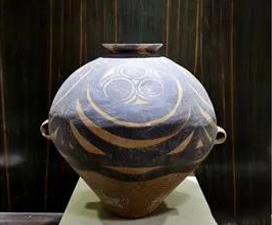
Appreciation of some auspicious patterns on Chinese ceramics
The patterns on Chinese ceramics are diverse and have profound meanings. They are all popular patterns among the common people and the powerful. They can fully reflect the ideological content and ideal pursuits of the makers and users. They also reflect the social trends of the time. ethos and political background. Learning and mastering the characteristics of related patterns will help you appreciate the age and artistic characteristics of porcelain from another aspect. By learning and mastering the meaning of related patterns, you will definitely bring more knowledge and happiness to collecting and appraising porcelain. “Every painting must be intentional, and if it is intentional, it must be auspicious.” The auspicious patterns on Chinese ceramics inherit the excellent culture of the nation and continue from ancient times to the present. From those unique patterns and symbols, we can understand the beauty of people in various dynasties. The yearning for life and the expectation for prosperity and stability of society and country.
Judging from the history of the development of ceramics, decorative patterns with beautiful meanings have accompanied the production and development process of ceramics from beginning to end. From primitive totems to logo patterns with rich emotional colors, ceramics have brought us joy and inspiration, allowing Chinese civilization to be passed down from generation to generation and enjoyed endlessly.
First of all, we can see some common rope patterns, water ripples, and fence patterns on primitive pottery, which reflect the life scenes of primitive ancestors. In particular, the painted pottery cultural decorations in the Yellow River Basin are often decorated with water ripples and reproductive totems. These are the most basic prayer expectations of primitive people. They come from life and are closer to life.
In the half-pottery and half-porcelain period of Qin and Han Dynasties, decoration began to reflect people’s increasingly rich material living standards. People prefer to decorate some of their material wealth on ceramics, such as chickens, ducks, fish and insects, pigs, dogs, horses and sheep, pavilions and pavilions. Some real life scenes are gradually reflected on ceramics. Specifically, we can see some “barn” decorations. Their exquisiteness of decoration and high degree of artistic generality are still breathtaking. From the perspective of the ideological nature of the decoration and the pursuit of the next life, people’s hope has strong primitive religious characteristics. With the improvement and development of the firing technology of the Erjin Yue kiln and the further expansion of the firing area, more artistic decorative patterns appeared in the field of vision of enthusiasts. Typical decorative patterns include: chicken head pot and sheep head pot. , lion candlesticks and other exquisite objects are still popular today.
The introduction of Buddhism in the Southern and Northern Dynasties added an ideological and religious theme to ceramic decoration. Buddhist culture was carried on ceramics and spread all over the country. The dissemination of ideas and culture through specific artifacts is like having wings and flying into thousands of households. Chinese civilization has entered a new historical height.
During the Tang and Song dynasties, from exaggeration to restraint, the culture of the Han nation experienced a rebirth. The aesthetic taste of the Tang Dynasty tended to be exaggerated. People regarded fatness as beauty, and the shapes of utensils were mainly plump. Porcelain sculptures are full of plump women, not only figures and animals, but also figures. Some common “Hu people” stickers on the decorative patterns of Changsha kilns in the Tang Dynasty were affected by the prosperity of export trade on the “Silk Road”. We can also see some with foreign styles, especially imitations of gold and silverware from the Middle East. In the production of ceramics, pots, cups, and plates are common, and Tang Sancai has a strong Western style.
After the “An-Shi Rebellion”, ceramic production in various places has mushroomed with the migration of technical personnel. In response to the north and south, decorative techniques began to change. Some text decorations on ceramics can better reflect the true thoughts of the people who made them at that time, but the strong local “Taoist” auspicious patterns firmly occupied the mainstream of decoration. It was not until the Song Dynasty that the benchmark for great aesthetic taste was established. The restrained, quiet, and plain-style decorative techniques finally stood at the pinnacle of the art world and led the world’s aesthetics for a thousand years.
The alternations of history are objective. In the Yuan Dynasty, the Central Plains were swept by the powerful cavalry of the Muslim steppe peoples. In the Muslim world, blue is a symbol of depth, purity and transparency, which can make people feel mysterious and tranquil. The Yuan Dynasty brought the “cobalt material” from the Middle East to the Central Plains, and perfectly combined it with Jingdezhen’s advanced porcelain-making technology and high-quality materials at that time. The world’s greatest blue and white porcelain suddenly broke out in front of the world, becoming a masterpiece for countless people in later generations. It is a masterpiece of art and has played a decisive beacon role in the production of ceramics in the world. Yuan blue and white decorative patterns are mainly based on mythological stories and exotic flower themes.
The Ming Dynasty entered the nascent stage of capitalist society, the social atmosphere became increasingly secular, and the ideology and culture became closer to people’s actual feelings of life. Due to the vigorous development of Yuan blue and white production in Jingdezhen and the continuous improvement of technical means, sales channels, and social acceptance, it had an impact on most ceramic production in the country during the Ming Dynasty. Traditional ceramic production areas basically tended to decline. Jingdezhen’s unique ceramic production made the world It is easier and easier to understand Chinese ceramics. Jingdezhen’s unique natural advantages, driven by its production technology level, finally pushed Chinese ceramics to the top of the world. Yongxuan Suma Liqing, Chenghua Doucai, and exported to the world during the transition period, these are the glories of Ming Dynasty porcelain. In the early stage, due to the influence of materials, decorative techniques mostly featured flowers, birds, fish, insects, and pavilions. Later, influenced by paintings and novels of the Yuan and Ming Dynasties, they were more common in character stories, and the content was more colorful. The porcelain for export was made to order based on samples, and the patterns were eclectic.
The aesthetics of the Qing Dynasty society advocated complexity. It inherited all the advantages and technologies of the previous dynasties, and ceramic production entered another peak. The shapes are blooming, and the decorative techniques are more innovative in inheriting the tradition. In the later period, due to the further development of material technology, various decorative methods emerged in endlessly. In order to meet the society’s large demand for porcelain and to improve productivity, Jingdezhen’s literati paintings such as light crimson color and new pastel color have entered the production of a large number of practical products. In order to meet the needs of the general public, the quality of products varies, and the nobility of porcelain And finally fell off the altar.
After liberation, ceramic decoration content was closer to the new socialist ideological trend and had a stronger political service function. In particular, the themes of the Cultural Revolution were more contemporary and a major landscape of Chinese ceramics.

Majiayao painted pottery (Machang type), decorated with water ripples (four circles). Height 45cm, diameter 15cm. The primitive ancestors pioneered the decoration of pottery. Water ripples are a common decoration on Majiayao pottery. Water cultivated the body and mind of primitive people, allowing primitive people to gain great spiritual enjoyment, which is reflected in the imitation and depiction of water and aquatic animals in patterns. The Majiayao-type swirl pattern reflects the people’s feelings about water in the upper reaches of the Yellow River at that time, and contains a kind of vitality and vitality. The swirl patterns on the painted pottery are deeply inspired by the rapid, rushing water. It reflects the totem of primitive civilization: worship of life and nature.
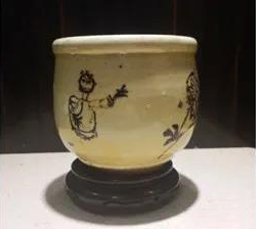
The Cizhou kiln bowl of the Yuan Dynasty has dynamic patterns of dolls and peonies on a brown canvas with a white background. The theme fully reflects the working people’s wish to have more children and more happiness.
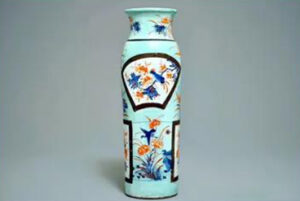
Ming Dynasty Chongzhen Greenland window-shaped vase with flower and bird patterns, 50 cm high, large in size and with strong color contrast. The main pattern is a ribbon bird and peony, with wild goose and peony underneath. The main meaning is wealth, longevity and the basic living state of life, “Feiming, accommodation and food”.
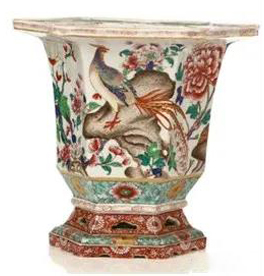
Qing Dynasty pastel pheasant and peony pattern flower pot, the height of the flower pot is 30 cm and the diameter is 25 cm. It is made of heavy work and color. It has a strong sense of decoration, and the main decoration is pheasant and peony, which symbolizes wealth and longevity and the beautiful meaning of longevity in the room.
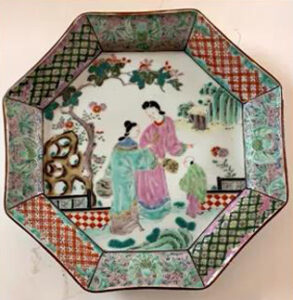
Qing Dynasty Yongzheng period, Sanniang taught her son a pastel octagonal plate. This plate has an Imari style. The decorative pattern is the famous story of Sanniang teaching her children in the Ming Dynasty, which means three obediences and four virtues, caring for her husband and teaching her children, and the connection of cause and effect.
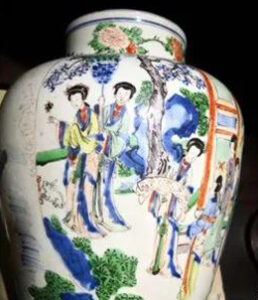
Kangxi Toad Palace Osmanthus Jar Toad Palace: Moon Palace. To break the osmanthus and climb the osmanthus in the moon palace. According to Chinese myths and legends, there is a three-legged toad in the Moon Palace, and later generations also referred to the Toad Palace as the Moon Palace. Climb and break the osmanthus in the Moon Palace. The imperial examination era is a metaphor for passing the exam.
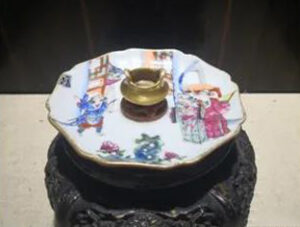
Daoguang, Qing Dynasty, The West Chamber, Hui Ming’s biography, incense and straw, bandit Sun Feihu led five thousand troops. They surrounded the Xiangguo Temple and wanted to force Cui Yingying to be the wife of Yazhai. Cui’s mother was helpless and said, “Whoever can defeat the traitorous soldiers is willing to give his little daughter as his wife.” At this time, Zhang Sheng was also in the temple. After hearing this, he hurriedly wrote a letter to his old friend General Du Que, Baima, in order to rescue the siege. In order to send this letter, Huiming, a monk in the temple, volunteered to go. So he broke out of the siege alone and went straight to General Baima in Puguan to write a letter asking for help.
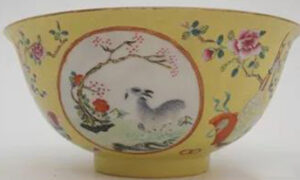
Guangxu Zhadao opened the window with three yangs to open the Thai bowl. The Chinese idiom of “three yangs to open the Thai bowl” means that the connected lines are called yang hexagrams, the broken ones are yin hexagrams, the first month is the tai hexagram, and the three yangs are born below; when winter goes and spring comes, yin When Yang disappears and grows, there is a sign of good fortune. It is often used to praise the beginning of the year or to imply good luck. It comes from “Yi Tai” and “Song History Le Zhi”. It is also a praise for prosperity and everything goes well. The pattern is symbolized by three sheep (homophone for “Yang”) grazing in the warm sunshine.
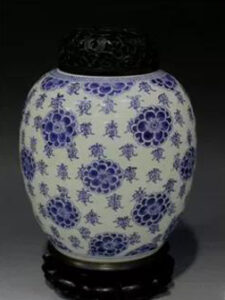
Kangxi Plum Blossom Hundred-Shou Jar The most common plum blossom symbolizes the first of the five blessings, which will bring happiness to people; this jar means: wealth and longevity. Baishou with plum blossom pattern is rare among similar types of utensils.
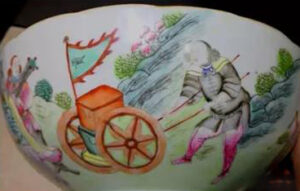
The Qing Jiaqing Pastel Eight Barbarians Providing Treasures Bowl is a vivid and lively painting of eight barbarians holding various treasures as tribute. Baman (eight chapters) is the collective name for eight ethnic minorities in the south (and also from neighboring countries). “Eight Barbarians Advance Treasures” has the implication of unifying the country and bringing all nations to court. According to the “History of the Ming Dynasty”, the “Eight Barbarians Presenting Treasures Dance” was played during the “Grand Banquet” during the Ming Dynasty’s court etiquette, and the “Jiuyi Treasure Troupe Dance” was played during the Wanshou Holy Festival banquet.
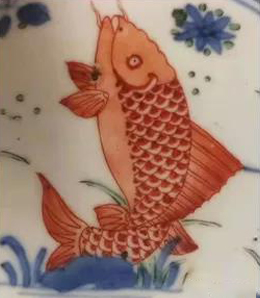
Emperor Kangxi of the Qing Dynasty learned about the blue and white multicolored plate in Sichuan. This story is a quarrel between Zhuangzi and Huizi. The allusion of “Zhichuan Zhile” comes from “Zhuangzi”. It talks about a famous conversation between Zhuangzi and Huizi when they were playing in Haoliang. They saw the fish playing freely in the water, and they had a famous conversation with Huizi. That is: Zhuangzi said, “The minnows travel calmly. This is It is the joy of fish.” Huizi said: “You are not a fish, how can you know the joy of fish?” Zhuangzi said: “You are not me, how can you know that I do not know the joy of fish?” Huizi said: “I am not a son, so I do not know the joy of fish. That’s right; you are definitely not a fish, but you don’t know the full joy of fish.
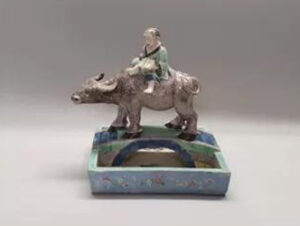
Water-washed pastel “ox horn hanging book” in Qianlong color of the Qing Dynasty (there is a pattern of Erjia Chuanlu in the inner hall), “New Book of Tang·Li Mi Biography”: “I heard that Bao Kai was in Fengshan, so I went to follow him. I rode an ox with a Pu’lan. , hang “Han Shu” on the corner of the cow’s horn, read it while reading.” The meaning of hanging the book on the cow’s horn is: study diligently. Due to workmanship issues, the horns are not hung with strings to avoid damage.
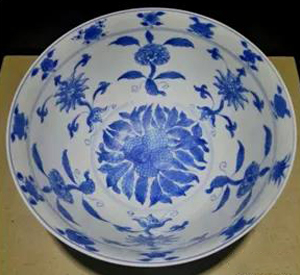
Qing Kangxi flower bowl (made in the Kangxi year of the Qing Dynasty) has flowers representing the December order on the rim. Among the legends of flowers, the legend of the flower god in the twelfth month of the lunar calendar is the most fascinating. The Flower God of December is a Chinese folklore. The 12th day of the second lunar month is the birthday of hundreds of flowers. People call it the Flower Festival. Therefore, Chinese people have a celebration of the Flower Dynasty. The most popular porcelain is the Kangxi December Flower God Cup. Famous. “Flower” can also represent “happiness”, so it can also represent the beautiful meaning of “happy every month”. In the middle is a rare “lychee” pattern, which means family and beauty.
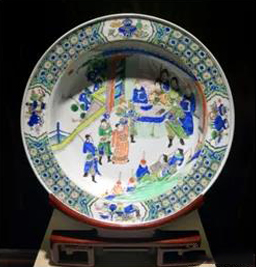
During the Northern Song Dynasty, when Western Xia invaded the Central Plains, Kou Zhun recommended generals from the Yang family to take command, and Wang Qiang of the Ministry of War recommended his son Wang Lun to take command. He won military power and joined forces with King Fan to seize the power of the Song Dynasty. The King of Song decided to select a marshal to lead the resistance through a competition in the school field. After hearing the news, Taijun She, who had resigned from the court for more than 20 years, hurriedly sent his great-grandsons Yang Wenguang and Jinhua to Kaifeng to inquire about the news. The two came to the “Tianbo Mansion”, the former residence of the Yang family general, with great interest. After hearing that Wang Lun was competing in the school field, the two hurried to the school field and saw that Wang Lun won the commander’s seal in the competition. The two refused to accept and proposed to compete with Wang Lun. Yang Wenguang recognized him as a descendant of the Yang family general and hinted that he was not guilty of killing Wang Lun. Yang Wenguang killed Wang Lun with a sword and won the commander’s seal. The King of Song ordered his mother Mu Guiying to lead the expedition.
Wen Guang and Jin Hua, who had won the seal of command, happily returned home and handed the seal to their mother. Mu Guiying was confused because the generals of the Yang family were ignored by the King of Song twenty years ago, so she immediately tied up her son and went to the palace to hand over the seal, and Jin Hua Please come out to Taijun She. When Taijun saw the handsome seal and returned to the Yang family, he was very excited and advised Mu Guiying to put the safety of the country first. Mu Guiying explained the reasons, and She Taijun said, “If you don’t want to take command, I will take charge.” She happily agreed to lead the troops to the expedition under Taijun’s inspiration. Mu Guiying took command. After some rectification of military discipline, he bid farewell to Taijun She and Kou Zhun who came to see him off, and the generals sent troops to Xixia.
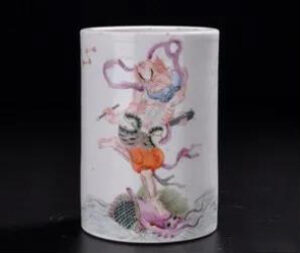
In the late Qing Dynasty, Kuixing dominated the pastel pen holder. Legend has it that Kuixing was a talented man. He once won three yuan (Jieyuan, Huiyuan, and Zhuangyuan) in a row. However, because of his ugly appearance, he frightened the queen and was kicked out of the palace. He jumped into the East China Sea in anger. The Jade Emperor deeply pitied him. He was given a red pen and ordered to take charge of the imperial examination and literary fortune in the world. “Being the best” has its origin. During the Tang and Song Dynasties, a dragon and an ao were carved on the stone slab in the middle of the steps of the palace hall. The high school’s Jinshi must stand on the steps to welcome the results, and the top scholar is honored to stand on Da Ao’s head, so it is said to “take the top spot.”

Qing Qianlong Tibetan Buddhist Treasure Pattern Doucai Bowl (Caihuatang Model) The rim of the bowl is surrounded by Tibetan Buddhist auspicious words. The five flowers in the interior are composed of red coral (coral is one of the eight treasures of Buddhism). It is said that they represent the “Five Buddhas”, namely: Vairocana Buddha, Akho Buddha in the East, Baosheng Buddha in the South, Amitabha in the West, The North is not empty and has attained Buddhahood. It also has the meaning of five blessings.
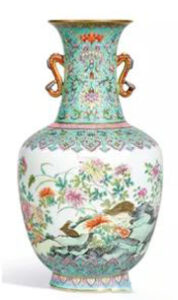
The main pattern of the Qianlong pastel Ruyi amphora in the Qing Dynasty is two quails, chrysanthemums and other patterns, which means peace and tranquility. The top of the head and neck is decorated with a red bat, etc., which means: blessings descend from the sky, and great blessings reach the sky.
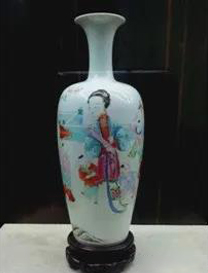
Qing dynasty pastel-painted willow leaf vase with images of ladies and infants playing. It means family happiness and many children and grandchildren.
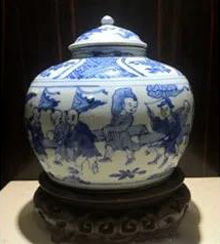
Ming Dynasty Wanli Baby Play Jar Lao Tzu often said: “Eternal virtue never leaves, and returns to the baby.” This means that people should often return to the state of a baby, innocent and innocent. This theme is called “baby play picture”. It’s called “ying”, but it actually means “child”. The children on the picture are either playing or having fun, in various poses and full of fun. It symbolizes many children, many blessings, a happy life, continuous birth of precious children, five sons passing the imperial examination, hundreds of descendants and thousands of grandchildren.
The auspicious patterns on porcelain are inexhaustible, and common auspicious patterns include: continuous melons, many seeds (seeds) and many blessings (Buddha’s hands), be granted a title immediately, clean and pure lotus, longevity mountain blessing sea, sea house Tiancai, happiness descending from the sky, flying Mingsu Food, wealth in the jade hall, auspiciousness from dragons and phoenixes, five sons to the imperial examination, five blessings and longevity, three levels in life, promotion to an official position, abundance every year, everything goes well, great blessings to the sky, three friends in the cold year, etc. The auspicious meaning brings wonderful enjoyment to us porcelain collectors.
Sadly, some people have vulgarized the auspicious patterns, such as drawing a fly on the back of a horse to say “win immediately”, drawing a spider on the instep to say “contentment and happiness”, and other jokes.
Learning and mastering the relevant meanings and origins of decorative patterns will be of great help in appreciating ancient ceramics. While appreciating the external beauty of Chinese ceramics, the rich decorative patterns will definitely bring more interest to ceramic collectors. Artistic enjoyment. It is expected that China’s excellent traditional culture will continue to be carried forward along with the production and dissemination of ceramics.

